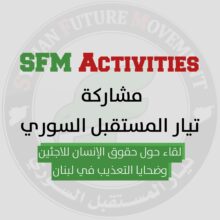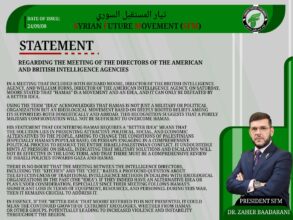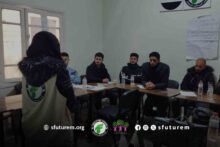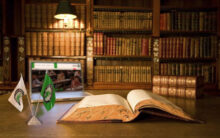The Syrian countryside is the cradle and colorant of the revolution.

Important | Download the full study file from here
Introduction:
The Palestinian social researcher, Hanna Batatu, tends to describe the inhabitants of Ghouta as city dwellers. He sees that many of their villages have urbanized. Moreover, he distinguishes between them and other rural inhabitants, such as in Al-Marj east of Ghouta. Those who, according to Batatu, still maintain behaviors and customs closer to Bedouins. As for the farmers of Houran, he classifies them somewhere in between the two categories. Hence, it’s not straightforward to apply the old classifications to every inhabitant of the countryside or the city. Even the countryside can be divided based on sectarian affiliation within the same region, a point also mentioned by Hanna Batatu. He describes some sects, like the Druze and Alawites, as being “among the most closed-off religious sects in Syria.” He adds, “The rule is that one cannot join these sects; one can only be born into them! They all possess a keen sense of their unique identity, driven by a strong sense of responsibility towards their co-religionists.”
The Social Status Between the Countryside and the City in Syria:
The social situation between the countryside and the city in Syria is a complex subject intertwined with historical, political, economic, and cultural factors. It cannot be fully understood without examining the context in which it emerged and the changes it underwent prior to the Syrian revolution, followed by the phase of the revolution and the subsequent war. Some of the main aspects of the social status between the countryside and the city in Syria can be summarized as follows:
1. Economic Conditions: Syrian rural areas suffered significant economic difficulties in the years preceding the revolution. Climate change and prolonged drought negatively impacted agriculture, leading many rural families to lose their primary sources of income. This, coupled with economic decline and widespread corruption, caused widespread resentment and anger among rural residents.
2. Government Negligence: The Syrian countryside faced the Assad regime’s policies that overlooked its economic, social, and cultural needs. This neglect impoverished, humiliated, and deprived the countryside of its basic rights. It also suffered exploitation, corruption, and suppression by the regime’s loyalists, officials, intelligence, and businesspeople. This situation contributed to a buildup of anger and frustration, culminating in peaceful protests where villagers demanded freedom, dignity, and justice.
3. Discrimination and Injustice: There was a general sentiment that the regime favored specific segments of society at the expense of others. This resulted in a sharp political divide between the rural bases supporting the Ba’ath Party and the urban educated classes opposing it.
4. Impact of Media and Social Communication: The spread of communication technologies and social media to rural areas facilitated the sharing of news, ideas, and events occurring globally. This increased awareness spurred the marginalized citizen’s desire for change, inspired by previous Arab Spring countries.
5. Social Gatherings: The Syrian countryside possessed a spirit of solidarity and cooperation, whether based on tribal, religious, or local foundations. This spirit facilitated the formation of coordination committees, armed brigades, and local councils to manage the revolution and confront regime forces. It also ensured the provision of material, human, and logistical resources for fighters and civilians in liberated areas.
6. Cultural Role: There might be cultural factors that make rural residents more inclined to mobilize and participate in the revolution compared to urban dwellers. The cultural and economic disparity between the countryside and the city is primarily the result of the Assad regime’s intentional neglect of rural areas and its preference for urban interests.
The children’s uprising in the countryside, and not in the cities, of Syria is due to several main reasons (taking Aleppo as an example (.
• The spark of the revolution began in the city of Daraa in the southern countryside of Syria. Citizens protested against the arrest and torture of a group of children who had painted anti-regime slogans on the walls of their school. The protests then spread to other rural areas like Hauran, Homs, and Idlib, where protesters faced persecution and repression by security forces.
• The revolution turned into an armed civil war, with various factions from the opposition and armed groups participating, relying on whatever weapons and military equipment they could find. Soon enough, regional and international support was provided, leading the country into a war that resulted in the displacement of millions of Syrians both internally and abroad. Both cities and countryside were affected (though to varying degrees) by bombing, sieges, and destruction.
• The demographic and cultural composition of both the countryside and the city in Syria changed due to both forced and voluntary migration. New phenomena like extremism, relief, and media emerged, leading to new social relationship networks that were either based on solidarity or conflict. Sorting then became based on affiliation, interest, and political stance, with some social values and practices being reinforced while others diminished or transformed.
In the peaceful phase, most Syrian regions, both urban and rural, participated in the Syrian movement. However, when the revolution shifted to military action, the cities retreated, while the villages and countryside generally carried the banner. For example, the city of Aleppo, the second-largest city in Syria and one of its main historical, cultural, and economic centers, lies on a river called Queiq. The city is divided into two main parts: East Aleppo and West Aleppo, separated by front lines that run through the city center.
East Aleppo: This is the older part of the city, containing many historical landmarks like the castle, its walls, the market, and mosques. In East Aleppo, the majority of the residents are from the lower and middle classes, and the culture there is predominantly popular and religious.
West Aleppo: This is the newer part of the city, home to many government institutions, universities, hotels, and malls. In West Aleppo, the majority of residents are from the wealthier, educated classes, and those involved in professions and services. The prevailing culture there is secular, conservative-liberal.
In 2011, the Syrian revolution erupted against the regime of Bashar al-Assad, with various segments of Syrian society participating. In both parts of Aleppo, participation in the revolution varied. While citizens in East Aleppo went out in peaceful demonstrations demanding freedom, dignity, and justice, facing arrest, bombing, and sieges by regime forces, the nature of the demonstrations in West Aleppo was milder and rarer. This was due to citizens’ fears of losing their livelihoods or facing violations by some of the regime-affiliated armed groups called “Shabiha”. There was also a segment of West Aleppo residents who supported the Assad regime or tried to be biased in its favor.
In 2012, the armed opposition entered Aleppo and took control over most of the districts of East Aleppo, while the regime forces maintained their grip on West Aleppo. A brutal street war ensued between the two sides, where heavy and aerial weaponry was used, resulting in massive destruction throughout the city, especially in its eastern part. In 2016, the regime forces, along with their allies, launched a military campaign against East Aleppo, managing to regain control over all its districts after a devastating bombing campaign and an agreement that led to the evacuation of fighters and civilians to other areas.
Today, regime forces retain control over the entirety of Aleppo, both east and west, while the northern regions of Aleppo, like the “Al-Bab” area, remain outside the regime’s control.
Similarly, we can also talk about the capital, Damascus, its extended countryside, and the Ghouta region, and so on.
In conclusion, the Syrian countryside was the backbone of the revolution against Bashar al-Assad’s regime, without denying the presence of revolutionaries and supporters in the cities. The passage discusses the Syrian revolution and how it has been influenced by the rural mindset. Here’s a brief summary:
The Rural Mindset in the Syrian Revolution:
1. Overview: The Syrian revolution has been significantly influenced by the countryside’s mindset. This is not meant to devalue or endorse the revolution, but rather a descriptive observation.
2. Characteristics of this Rural Mentality:
a. Reverence for traditions, tribalism, and clan affiliations, prioritizing social and religious ties over legal contracts and citizenship.
b. A disdain for all forms of plurality, especially political ones. Factions that control certain areas rarely agree on a common social contract.
c. Less interest in commercial, investment, and consumer aspects, focusing more on agricultural and traditional aspects.
d. Ideals are prioritized over practical realities, leading to extreme positions and rarely any middle ground.
e. Clinging to identity, fearing innovation and rejecting modernity.
Conclusion: The text suggests that these characteristics are intrinsic to the Syrian culture, with its positives and negatives. The aim is not to indulge in the common Syrian debate about “rural vs. urban” but to understand the reality of the situation. The Syrian people have been subjected to oppression since the 1970s, starting with the rise of the Arab Socialist Ba’ath Party and Hafez al-Assad’s purported “Corrective Movement.” The mention of these social conditions is an attempt by the “Syrian Future Movement” to comprehend the entirety of the Syrian situation and to highlight the societal reasons behind the political and revolutionary developments.
The passage highlights the importance of understanding the underlying societal structures and beliefs that influenced the trajectory of the Syrian revolution and the country’s broader political and social landscape.
| Ibrahim Moustafa Researcher in the Research and Studies Department Scientific office Syrian Future Movement (SFM) |
| Translated by Mr. Jamal Mamo Head of Translation Department in Syrian Future Movement (SFM) |






